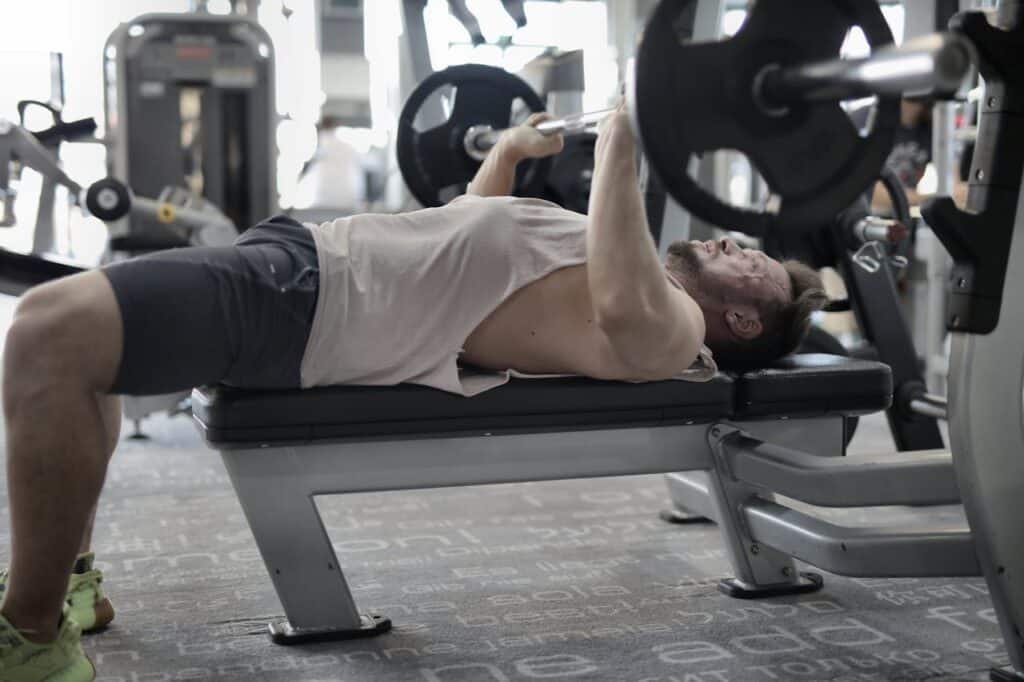Share on
Let’s talk chest and triceps – the dynamic duo of upper body aesthetics and function. Forget bro-science; we’re diving into evidence-based hypertrophy with a side of real-world application. First things first: your pecs aren’t just for filling out t-shirts. They’re prime movers in horizontal adduction and internal rotation of the humerus. Translation? Pushing stuff and looking good doing it.
As for triceps, these three-headed beasts make up about 2/3 of your upper arm mass. Neglect them, and your arms will look as impressive as a wet noodle. Now, I could bore you with the intricacies of myofibrillar hypertrophy, but let’s cut to the chase: progressive overload, compound movements, and enough protein to make a cow nervous. Stick with me, and you’ll be busting out of dress shirts in no time. Just don’t come crying when you can’t scratch your own back.
Key Takeaways
-
- Combining chest and tricep exercises is an efficient way to maximize your gym time and achieve well-rounded upper body development.
-
- Proper form and progressive overload are essential for injury prevention and consistent strength and muscle gains.
-
- Incorporating a variety of exercises that target different angles and muscle heads is crucial for comprehensive chest and tricep development.
-
- Adequate warm-up, rest intervals, and recovery strategies are just as important as the workouts themselves for optimal results and long-term progress.
Table of Contents

I. Introduction to Chest and Tricep Workouts
A. Benefits of combining chest and tricep exercises
When it comes to upper body workouts, combining chest and tricep exercises is a match made in muscle-building heaven. Not only does it allow for an efficient use of gym time, but it also targets complementary muscle groups that work together to create a well-rounded physique. By training chest and triceps in the same session, you can achieve enhanced muscle growth and strength gains that will have you flexing in front of the mirror in no time.

B. Anatomy overview of chest and tricep muscles
Before we dive into the essentials of the workouts, let’s take a moment to appreciate the stars of the show: the chest and tricep muscles. The chest is primarily composed of the pectoralis major and minor, which are responsible for movements like pushing and adduction of the arm. The triceps, on the other hand, are made up of three heads: the long, lateral, and medial. These muscles work together to extend the elbow and support the chest in various pushing movements.
C. Importance of proper form and progressive overload
Now, I know you’re eager to start throwing around some heavy weights, but hold your horses! Before we get into the workouts, it’s crucial to understand the importance of proper form and progressive overload. Proper form not only helps prevent injuries but also ensures that you’re maximizing muscle activation and growth. Progressive overload, on the other hand, involves gradually increasing the weight, reps, or sets over time to continually challenge your muscles and achieve consistent strength improvements. Trust me, your future self will thank you for prioritizing these principles.

II. Beginner-Friendly Chest and Tricep Workout
A. Machine-based exercises for controlled strength gains
If you’re new to the wonderful world of chest and tricep training, don’t worry – we’ve got your back (and your front!). For beginners, starting with machine-based exercises can be a great way to build a foundation of strength while maintaining control and proper form. Some go-to machine exercises include the machine chest press, assisted dips, and cable tricep extensions. These movements allow you to focus on the target muscles without the added complexity of free weights.
B. Sample workout routine for beginners
Ready to put this knowledge into practice? Here’s a sample workout routine tailored for beginners:
-
- Machine chest press: 3 sets of 10-12 reps
-
- Assisted dips: 3 sets of 10-12 reps
-
- Cable tricep extensions: 3 sets of 10-12 reps
Remember to rest for 60-90 seconds between sets and focus on form and controlled movements. Aim to incorporate this workout 1-2 times per week, alongside other upper body exercises for balanced development.
C. Tips for proper execution and progression
As you embark on your chest and tricep journey, keep these tips in mind for proper execution and progression:
-
- Start with lighter weights to master the form before gradually increasing the load.
-
- Gradually increase weight and decrease reps as your strength improves to continue challenging your muscles.
-
- Listen to your body and don’t be afraid to adjust the weight or reps as needed to maintain proper form.
| Exercise | Sets | Reps | Rest |
|---|---|---|---|
| Machine chest press | 3 | 10-12 | 60-90 sec |
| Assisted dips | 3 | 10-12 | 60-90 sec |
| Cable tricep extensions | 3 | 10-12 | 60-90 sec |

III. Intermediate Chest and Tricep Workout
A. Free-weight exercises for increased challenge
Congratulations, you’ve graduated from the beginner level! As an intermediate lifter, it’s time to step up your game and incorporate free-weight exercises for an increased challenge. Dumbbell bench presses, bodyweight dips, and skull crushers are all excellent choices to take your chest and tricep development to the next level. These exercises require more stabilization and coordination, leading to improved overall strength and muscle activation.
B. Sample workout routine for intermediates
Ready to tackle the intermediate level? Give this sample workout routine a try:
-
- Dumbbell bench press: 4 sets of 8-10 reps
-
- Bodyweight dips: 3 sets of 10-12 reps
-
- Skull crushers: 3 sets of 10-12 reps
Aim for 60-90 seconds of rest between sets and focus on maintaining proper form throughout each exercise. As an intermediate lifter, you can increase the frequency of your chest and tricep workouts to 2-3 times per week, depending on your overall training split.

C. Incorporating progressive overload techniques
To continue making gains as an intermediate lifter, it’s essential to incorporate progressive overload techniques. Some effective strategies include:
-
- Increasing the weight by 2.5-5% when you can comfortably complete all the prescribed reps with proper form.
-
- Adding extra sets to your workouts or decreasing rest time between sets to increase overall volume and intensity.
-
- Varying rep ranges (e.g., 6-8 reps, 12-15 reps) to target different muscle adaptations and prevent plateaus.
| Exercise | Sets | Reps | Rest |
|---|---|---|---|
| Dumbbell bench press | 4 | 8-10 | 60-90 sec |
| Bodyweight dips | 3 | 10-12 | 60-90 sec |
| Skull crushers | 3 | 10-12 | 60-90 sec |

IV. Advanced Chest and Tricep Workout
A. Heavy barbell-based training for strength and muscle gains
Alright, you seasoned lifters, it’s time to bring out the big guns (pun intended). For advanced athletes looking to maximize strength and muscle gains, heavy barbell-based training is the way to go. Exercises like the barbell bench press, weighted dips, and close-grip bench press will push your chest and triceps to their limits, eliciting serious gains in both size and strength.
B. Sample workout routine for advanced athletes
Ready to take on the challenge? Here’s a sample workout routine designed for advanced athletes:
-
- Barbell bench press: 5 sets of 5-8 reps
-
- Weighted dips: 4 sets of 8-10 reps
-
- Close-grip bench press: 3 sets of 8-12 reps
Rest for 90-120 seconds between sets to allow for adequate recovery and maintain high-intensity output throughout the workout. As an advanced lifter, you can incorporate chest and tricep-focused workouts 2-3 times per week, depending on your goals and overall training split.
C. Advanced techniques for muscle growth and strength
To keep progressing as an advanced lifter, it’s crucial to incorporate advanced techniques that push your muscles to the limit. Some effective strategies include:
-
- Drop sets and supersets to increase the intensity and volume of your workouts, leading to increased muscle fatigue and growth.
-
- Partial reps and isometric holds to target specific ranges of motion and create greater muscle tension.
-
- Periodization techniques, such as undulating or block periodization, to prevent plateaus and optimize gains over the long term.
| Exercise | Sets | Reps | Rest |
|---|---|---|---|
| Barbell bench press | 5 | 5-8 | 90-120 sec |
| Weighted dips | 4 | 8-10 | 90-120 sec |
| Close-grip bench press | 3 | 8-12 | 90-120 sec |

V. Targeting Different Angles and Muscle Heads
A. Incline and decline exercises for chest development
To achieve a well-rounded chest, it’s essential to target the muscle from different angles. Incline exercises, such as the incline dumbbell press, emphasize the upper chest, while decline exercises, like decline push-ups, focus on the lower chest. Incorporating both incline and decline movements in your chest workouts will lead to more complete development and a more aesthetically pleasing physique.
B. Variations to hit all three tricep heads
Similarly, targeting all three heads of the triceps is crucial for balanced development and overall arm strength. Exercises like overhead tricep extensions emphasize the long head, while rope pushdowns target the lateral and medial heads more effectively. By including a variety of tricep exercises in your workouts, you’ll ensure that no head is left behind (pun intended, again).
C. Importance of exercise variety for comprehensive development
In addition to targeting different angles and muscle heads, exercise variety is key for comprehensive chest and tricep development. This means:
-
- Rotating exercises every 4-6 weeks to prevent adaptation and maintain progress.
-
- Incorporating both multi-joint and isolation movements to target the muscles from different angles and improve overall functional strength.
-
- Balancing push and pull exercises (e.g., rows and pull-ups for the back and biceps) to maintain proper posture and prevent muscle imbalances.

VI. Proper Warm-up and Recovery Strategies
A. Dynamic warm-up routine for chest and triceps
Before diving into your chest and tricep workout, it’s crucial to prime your muscles and joints with a proper dynamic warm-up routine. This can include exercises like:
-
- Arm circles and shoulder rotations to lubricate the joints and increase blood flow.
-
- Push-up variations with increasing difficulty to gradually activate the chest and triceps.
-
- Light resistance band exercises to further engage the target muscles and improve mind-muscle connection.
B. Importance of rest intervals during workouts
In addition to warming up, rest intervals play a significant role in the effectiveness of your chest and tricep workouts. For optimal muscle growth, aim for 30-90 seconds of rest between sets, depending on the exercise and your training goals. When focusing on heavy strength training, longer rest periods of 2-3 minutes may be necessary to maintain high-quality output and prevent fatigue.

C. Post-workout recovery techniques
Once you’ve completed your workout, don’t just head straight for the showers! Post-workout recovery is just as important as the workout itself for optimal gains and long-term progress. Some essential recovery techniques include:
-
- Performing a proper cool-down and stretching routine to reduce muscle soreness and improve flexibility.
-
- Providing your body with the necessary nutrients for muscle repair and growth, including adequate protein and carbohydrates.
-
- Prioritizing adequate sleep and rest days between workouts to allow your muscles time to recover and grow.

VII. Common Mistakes and How to Avoid Them
A. Overtraining chest and triceps
One of the most common mistakes lifters make is overtraining their chest and triceps. Signs of overtraining include persistent soreness, decreased performance, and plateaus in strength and muscle gains. To avoid this, be sure to:
-
- Incorporate rest days and deload weeks into your training plan to allow for adequate recovery.
-
- Listen to your body and adjust your training volume and intensity as needed to prevent burnout.
B. Neglecting proper form for heavier weights
Another common pitfall is sacrificing proper form in pursuit of heavier weights. Not only does this increase the risk of injury, but it also reduces muscle activation and growth. To maintain proper form as the weight increases:
-
- Focus on controlled eccentric (lowering) movements and explosive concentric (lifting) movements.
-
- Engage your core and stabilizer muscles throughout each exercise to maintain proper alignment and prevent compensations.
-
- Don’t be afraid to reduce the weight or reps if you find yourself struggling to maintain proper form.
C. Imbalanced training leading to muscle imbalances
Finally, many lifters fall into the trap of imbalanced training, neglecting other muscle groups in favor of their chest and triceps. This can lead to muscle imbalances, poor posture, and an increased risk of injury. To prevent this:
-
- Incorporate exercises for antagonist muscle groups, such as the back and biceps, to maintain balance and proper posture.
-
- Include unilateral exercises (e.g., single-arm dumbbell press, single-arm tricep extensions) to address any asymmetries and promote even development.

VIII. Nutrition and Supplementation for Chest and Tricep Growth
A. Macronutrient requirements for muscle building
In addition to proper training, nutrition plays a crucial role in supporting chest and tricep growth. To optimize muscle building, focus on consuming:
-
- Adequate protein (1.6-2.2g per kg of body weight) to support muscle repair and growth.
-
- Complex carbohydrates to provide energy for intense workouts and replenish glycogen stores.
-
- Healthy fats to support hormone production and overall health.
B. Meal timing around chest and tricep workouts
Meal timing is another important factor to consider when training chest and triceps. For optimal performance and recovery:
-
- Consume a pre-workout meal containing easily digestible carbohydrates and protein 1-2 hours before your workout to provide energy and support muscle growth.
-
- Prioritize a post-workout meal containing fast-acting protein and carbohydrates within 30-60 minutes of completing your workout to jumpstart the recovery process.

C. Supplements to support chest and tricep development
While a well-rounded diet should always be the foundation, certain supplements can support chest and tricep development by enhancing performance, recovery, and muscle growth. Some evidence-based options include:
-
- Creatine monohydrate to improve strength and muscle gains over time.
-
- Whey protein powder to conveniently increase protein intake and support muscle repair and growth.
-
- Branched-chain amino acids (BCAAs) to reduce muscle soreness and promote recovery between workouts.

IX. Tracking Progress and Adjusting Your Routine
A. Methods for measuring chest and tricep growth
To ensure that your hard work is paying off, it’s essential to track your progress over time. Some effective methods for measuring chest and tricep growth include:
-
- Taking body measurements of your chest and arm circumference to monitor changes in size.
-
- Progress photos taken every 4-6 weeks to visually assess changes in muscle definition and overall physique.
-
- Tracking strength increases in key lifts, such as the bench press and weighted dips, to ensure that you’re continually improving.
B. When and how to modify your workout routine
As you progress in your chest and tricep training, there may come a time when you need to modify your workout routine to continue making gains. Some signs that it’s time for a change include:
-
- Plateaus in strength or muscle growth despite consistent training and progressive overload.
-
- Boredom or lack of motivation with your current routine.
-
- Changes in goals or priorities, such as shifting from muscle growth to strength or endurance.
When modifying your routine, consider strategies like changing exercise selection, rep ranges, or training frequency to provide a new stimulus for growth and keep things fresh.
C. Setting realistic goals and expectations
Finally, it’s crucial to set realistic goals and expectations for your chest and tricep development. While everyone’s progress will vary based on factors like genetics and training experience, some general guidelines include:
-
- Aiming for 0.5-1% of body weight in muscle gain per month as a beginner, and 0.25-0.5% per month as an intermediate or advanced lifter.
-
- Aim for realistic strength goals. This will vary per individual, but gaining 5 to 10 lbs to your bench a month is a phenomenal accomplishment. Pursue small increments in strength gains per month. I can’t put an exact number on it because results will vary.
Conclusion: Time to Crush It
Alright, gents, we’ve covered a lot of ground here. From beginner machine work to advanced barbell beatdowns, we’ve laid out the blueprint for building a chest that could stop bullets and triceps that look like horseshoes.
Remember these key points:
-
- Progressive overload is king. Keep challenging yourself, or you’re just spinning your wheels.
-
- Form trumps ego. Leave your pride at the door and focus on proper execution.
-
- Variety is the spice of gains. Mix up your exercises to hit all angles and muscle heads.
-
- Recovery isn’t for the weak; it’s for the smart. Rest, eat, and grow.
-
- Track your progress like a scientist tracking a new species. Numbers don’t lie.
Now, you might be tempted to treat this information like that kale salad your girlfriend keeps pushing on you – acknowledge its existence but never actually use it. Don’t. The difference between the guy with the impressive upper body and the one who looks like he apologizes for taking up space is consistent, intelligent effort.




Pingback: Efficiency Meets Muscle: The Complete Full Body Workout Manual - Counting Kilos